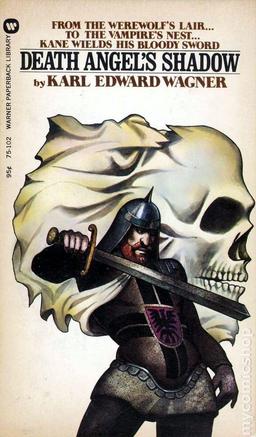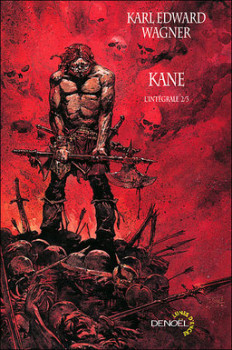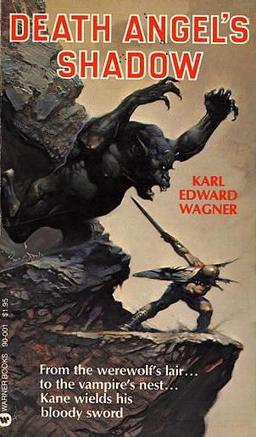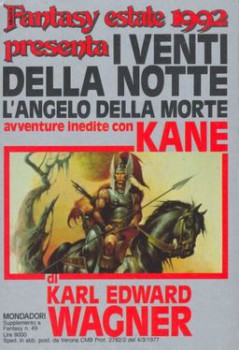Death Angel’s Shadow by Karl Edward Wagner

I’ve read Karl Edward Wagner‘s Death Angel’s Shadow (1973), with its three stories of Kane, the Mystic Swordsman, numerous times since first finding it in my attic in the 1970s. Before Conan’s or Elric’s, Kane’s adventures sparked my interest in swords & sorcery. Only a few years ago, I wrote a long piece about Wagner and this book over at my site, Swords & Sorcery: A Blog. I figured it was time to give it a reread and review here at Black Gate.
For the uninitiated, Kane is, in Wagner’s own words, a villain-hero. Cursed with immortality, over the course of his career he’s been an evil wizard, a crime lord, a bandit, and the general of a demon cult’s army. Sometimes he’s up against someone more diabolical than he is, but he’s never the good guy, never the hero.
This description of him gives you a sense of the wrongness that clings to him even when he’s not embarked on some nefarious plan:
It was his eyes that bothered Troylin. He had noticed them from the first. It was to be expected, for Kane’s eyes were the eyes of Death! They were blue eyes, but eyes that glowed with their own light. In those cold blue gems blazed the fires of blood madness, of the lust to kill and destroy. They poured forth infinite hatred of life and promised violent ruin to those who sought to meet them. Troylin caught an image of that powerful body striding over a battlefield, killer’s eyes blazing and red sword dealing carnage to all before it.
The three Kane novels, Darkness Weaves, Bloodstone, and Dark Crusade, are decent enough, but it’s in the short stories that Wagner’s immense talents shine most brightly. Two years ago I reviewed the collection, Night Winds (1978) at Black Gate. That book contains some of the best and darkest S&S stories ever set to paper. I cannot recommend it highly enough.
Horror has always been an important element of S&S. It’s there from the start, all the way back to Robert E. Howard and C.L. Moore. In a comment on the Night Winds review, Keith West wrote:
I think horror is essential to what makes sword and sorcery distinctive from other forms of fantasy adventure. The best S&S stories Robert E. Howard wrote are infused with a sense of dread or horror. Think “Tower of the Elephant” or “Worms of the Earth,” to name just two examples. Without the horror element, a lot of what is marketed as S&S is really just fantasy adventure with S&S trappings.

The thing is, horror was only one of many elements in Howard, Moore, et al.’s stories; it’s the primary one in Wagner’s. In fact, I tend to think of the Kane stories as horror before I think of them as S&S. They’re filled with all sorts of monsters and demons. More than that, they’re imbued with an atmosphere of terror and darkness. Wagner was a student of horror and one of the genre’s finest and most important editors (he edited DAW’s The Year’s Best Horror Stories from 1980 to 1994). His deep intimacy with horror meant that when he set out to scare you or creep you out, he was going to pull it off masterfully.
“Reflections for the Winter of My Soul” kicks off Death Angel’s Shadow with a blast of icy wind. Kane, being tracked by fanatical killers, finds himself lost in the middle of a forest during a blizzard. He also suspects, though the weather should make it unlikely, he is being stalked by a pack of wolves. Only a fortuitously open gate at a manor house lets him escape the cold and his hunters.
Despite the monstrous wolves and a seemingly sorcerous snowstorm, the story is structured like a country house mystery. There’s a limited cast of characters, isolated from anyone and anywhere else. Then there’s a crime for which one of them must be the culprit. The crime’s not one you might find in a book by Agatha Christie or Dorothy Sayers, though. A servant is torn to pieces by something in the woods. As he is dying he says, “Death! I see him! Out of the storm he comes for us all!”
When Kane awakens, inside the warm and seemingly safe manor, he meets Baron Troylin, his family, and his retinue. His beautiful young daugher is named Breenanin and she is drawn to the red-haired stranger. Then there’s his son, Henderin. He’s clearly got some loose screws, falling into a rage when the meat he’s served at dinner isn’t “raw flesh.” Next is the court astrologer and Henderin’s physician, Lystric. He fears Kane. First, because he feels threatened by anything that he perceives as disrupting his place in the household, and second, because he has his suspicions about who Kane really is. Evingolis, the albino minstrel recently taken under Troylin’s wing, is the last major player. Evingolis knows more about Kane and his murderous past than Kane would like.
It’s a really good story. There’s a boar hunt where the hunters quickly find themselves the quarry. Wagner builds a sense of claustrophobia and suspicion that begins on the very first page and never lets up until it explodes in death and entrails. “Reflections” is also filled with great world-building detail. There are short bits of history that explain why Kane and Troylin are where they are. It’s a direct sequel to the novel Dark Crusade, and also references other stories. And it moves, it moves like water crashing through a broken dam, roaring down the valley, picking up speed, then crushing everything.

And yet I found myself nitpicking the story for the first time. Perhaps I’ve read it too many times and I can’t be totally caught up in the story itself anymore. Instead I saw the seams and joints. Kane’s attraction to Breenanin reads forced and overplayed. Kane also seems a little dumber than I expect from an immortal sorcerer when he tries to deduce who the secret villain is. Which leads to my last complaint — the question of who or what is behind the story’s bloody events. If you can’t figure it out you should lose your fantasy membership card. These things don’t ruin the story but they definitely distracted me this time around.
“Cold Light” is like a Western where a marshal has hunted an outlaw across the West before a final showdown in a dusty border town. Kane has been tracked to a near-empty oasis town by a knight bent on vanquishing any and all forces of evil in the world. The knight, Gaethaa the Crusader, is accompanied by a band of soldiers, only one of whom is a true believer in his mission. The rest are there for the money or revenge against Kane.
As Wagner reveals the motives of each of Gaethaa’s men we get to know how evil Kane has been. One soldier saw his family butchered before Kane chopped his hand off. Kane sacrificed the sisters of another for a dark ritual. Then there was the rival bandit leader whom Kane overthrew and staked out in the desert to die.
Gaethaa’s band track Kane to the mostly depopulated city of Sebbei. Once it was a wealthy trading center in a green oasis in the middle of a desert. Then a plague came and killed nearly everyone. Those who remain are too worn down to care about anything, let alone Kane or those hunting him.
Much of the story is an exciting hunt through the empty city, as Gaethaa, his men, and Kane stalk each other through dead streets and crumbling buildings. There’s lots of swift, bloody action in “Cold Light.”
A figure approached him along the wall, striding through the mist as ominously as the angel of death.
Menace radiated from the fog wrapped figure, shone in his killer’s eyes, gleamed along his drawn sword.
“Kane!” gasped Missa, recognizing the singed and bandaged swordsman. Only a second did he waste on amazed confoundment. Missa’s own blade leapt from the scabbard to answer Kane’s challenge!
Kane rushed upon the Waldann, his sword hissing through the fog. Missa’s blade moved in swift parry, then thrust past in a sudden lunge.
Wagner gives us just sufficient insight into the motives of both men to keep us satisfied. Gaethaa, disgusted with the soft, indulgent lives of the nobility to which he was born, forged himself into a weapon by which to destroy evil wherever it inflicted itself on humanity. Kane, following one more series of failed undertakings, has chanced upon Sebbei and now hopes to find peace there. He even meets a girl.
Yeah, the girl. Her name’s Rehhaile and she’s the weak part of “Cold Light.” For what seems to be no more than a cheap plot device, she’s got psychic powers. She’s blind and she can sense another person’s thoughts. Wagner describes this in the cheesiest sentences I’ve read in some time:
But Rehhaile had been blind since birth. And yet she had in place of sight an infinitely more precious power of vision. Her macabre birth, a genetic mutation, some whim of the gods — the reason was unknowable and unimportant. She was given a psychic talent that provided a far more wondrous sense of perception than any human eyes could afford.
I’d like to think I always cringed a little reading those words in the past and have just been lucky enough to forget them. Not so this time around. They’ll be knocking around my skull for weeks, which makes me truly unhappy.
It’s a great leaden lump of plot-cooking that sticks out in an otherwise great story. We get Kane as a brooding dark figure up against a someone unwilling to see the world in anything but black and white. Wagner forces us to choose sides between an utterly despicable villain and a cold-hearted fanatic who is absolutely right in this case. Almost a model of what S&S should be. Except for the psychic girl.
 The last story, “Mirage,” continues Wagner’s style-hopping: it’s a Gothic. According to Wikipedia, a Gothic story attempts to achieve a “pleasing sort of terror.” With ghouls, vampires, and a ruined castle, this story’s got that covered.
The last story, “Mirage,” continues Wagner’s style-hopping: it’s a Gothic. According to Wikipedia, a Gothic story attempts to achieve a “pleasing sort of terror.” With ghouls, vampires, and a ruined castle, this story’s got that covered.
Fleeing a civil war where he worked for the losing side, Kane finds himself ensnared by the wiles and illusions of a vampire. It’s a spooky romance, where Kane’s long life of murder and bloodshed seems to have become too much for him to bear anymore. Finally, he feels, there might be some escape from it.
My opinion on this story, sadly, has remained the same: it’s a little dull. It’s like a Hammer Horror film: good costumes, good atmosphere, and nothing really exciting happens. Maybe some glowering and an accidentally exposed fang or two. Still, it’s Wagner showing off his love for the Gothic tradition and how far the boundaries of S&S could be pushed.
Death Angel’s Shadow is not the perfect book of my memory. The stories, good as they are, are flawed in ways that had escaped my notice until now. Or I simply refused to acknowledge them because this is THE book that introduced me to swords & sorcery, and it was my dad’s, and it has the only cover to do justice to Kane. Whichever case, it makes me a little sad.
On the other hand, it’s satisfying that I can spot the problems and call them out. If a critic can’t do that with an artist he loves, why bother writing in the first place? If I can’t be honest about the story to myself there’s no way I’m going to be able to be honest about it to anyone else.
So I will still tell anyone who’s interested to give Death Angel’s Shadow a read. Karl Edward Wagner is a dark son to Robert E. Howard, and Kane walks a more shadowy path than Kull or Conan ever did. Long before most of the grimdarkers were born, Wagner was bringing grim and dark to fantasy. And when you’re done, if you haven’t already, read Night Winds to see what Wagner could really do.
Until recently, readers had to make do with beat up old paperbacks or overpriced out-of-print omnibuses to get their hands on the Kane stories. I’m happy to report that that’s changed, and the fine folks at Gateway have made them all available as cheap e-books.
This was my introduction to Kane, and I enjoyed them all (mind you, I was sixteen at the time) with ‘Reflections for the Winter of my Soul’ being my favourite. Oddly enough, I didn’t spot the culprit. There seemed to be quite a few albinos holed up in that manor!
Also, kudos to Wagner for the werewolf’s transformation scene, which differs from any other I’ve read.
Thanks for the post–love me some KEW!
“Horror has always been an important element of S&S.” You’re not the first person I’ve seen to make that claim. But I’m not sure that’s true or I’m not entirely sure what you mean.
Moorcock’s Elric stories are usually classified as S&S. But it’s hard for me to see any horror element in them. Same goes for Leiber’s Nehwon stories. Am I missing something?
Again, thanks for the post!
@Angus – indeed, the werewolf scene is great.
@James – You’re welcome!. KEW really was one of the best. Cranky as I sound in this piece, I still dig these stories.
I believe the roots of S&S are in the campfire stories of the mythic past and as such reflect our fear of whatever lurks in the dark. Most S&S takes place in dark worlds haunted by ghosts, with demons lurking in every shadow. Conan never rode through the sun dappled forests of Middle-earth.
It shows up in Jirel of Joiry’s descents into the underworld, as well the much of Clark Ashton Smith’s entire S&S catalogue. “Worms in the Earth” by REH is pretty horrific and directly connected to Arthur Machen’s horror stories about the “little people.”
I’d also argue there’s lots of horror stuff in Moorcock and Leiber as well. Sure, they were often poking fun or deconstructing the tropes of the genre and you can see the greasepaint, but they were also true to the genre as well.
Think of all the body horror in Moorock: Arioch in the Corum books, the fate of Elric’s wife, the king of Nadsokor, etc.
The Gods of Lankhmar are pretty creepy. “The Hollowing Tower” is a ghost story. And there’s more.
For me, true S&S is as much about a dark, foreboding atmosphere as it is about bravery and adventure.
“I believe the roots of S&S are in the campfire stories of the mythic past and as such reflect our fear of whatever lurks in the dark. Most S&S takes place in dark worlds haunted by ghosts, with demons lurking in every shadow. Conan never rode through the sun dappled forests of Middle-earth.”
@ Fletch Spot on. Nailed it. Fletcher if that was a hit in baseball the ball would still be sailing.
@Angus—I thought the werewolf was chilling.
I sure wish that there were a lot more S&S stories out there. You guys have any new writers you want share?
And another series gets added to the infinitely-growing to-be-reread pile …
@Wild Ape – thanks!
New S&S writers? Yeah, there’s tons of ’em. Because we’re here, Black Gate’s alums Howard Andrew Jones, James Enge, and John Fultz leap to mind. Then Milton Davis. Then Raphael Ordoñez.
Then more than I can mention here. There are so many folks writing amazing stories every month that it’s gotten impossible to remember everybody whose written something I really like.
Don’t forget Clark Ashton Smith’s ‘Tale of Satampra Zeiros”, a sword and sorcery story that is also very much a horror story. There’s also Michael Shea’s Nifft the Lean – a lot of very creepy stuff in those.
“For me, true S&S is as much about a dark, foreboding atmosphere as it is about bravery and adventure.”
Aah! That makes more since then simply saying “horror,” though I see your point more clearly now.
@Fletcher—Milton Davis rocks, I have Fultz’s new book in the que, I’ll have to check into James Enge. Thanks!
My feelings on Howard Andrew Jones is same as yours. He is awesome.
I was quite impressed by Death Angel’s Shadow. Given the style and time of writing, I was expecting something rather trashy, which Kane really is not.
Bloodstone was okay, but wasn’t that impressive.
@ Martin – The man was one of the best short story writers in his fields. His straight horror is among the best ever written. His novels, not so much.
Like Bloodstone, Dark Crusade and Darkness Weaves are decent enough, but no more than that.
I also loves me some Kane. I’m debating at this very moment on whether it invest in the new Centipede Press hardbacks or not.
I own the UK paperbacks and can’t decide if a book boner is enough justification to invest the hard earned dollars or not.
And as an aside….
Maybe it was a narrative necessity, but i was always bothered by the fact that Kanes truly horrible deeps were always in the past and/or offstage.
I’m guessing that this is what has to be done in order for him to a be a bastard who you can root for (i.e. Bad vs. Evil) and not a mad dog monster in human form who you want to see taken down at the earliest possible opportunity.
Doug
[…] Shall Be No Darkness” by James BlishThe Were-wolf in Lore & Legend by Montague SummersBlack Gate review by Fletcher VredenburghVR Food and @vrfood_filmThe Beast Must Die!The Spine of […]